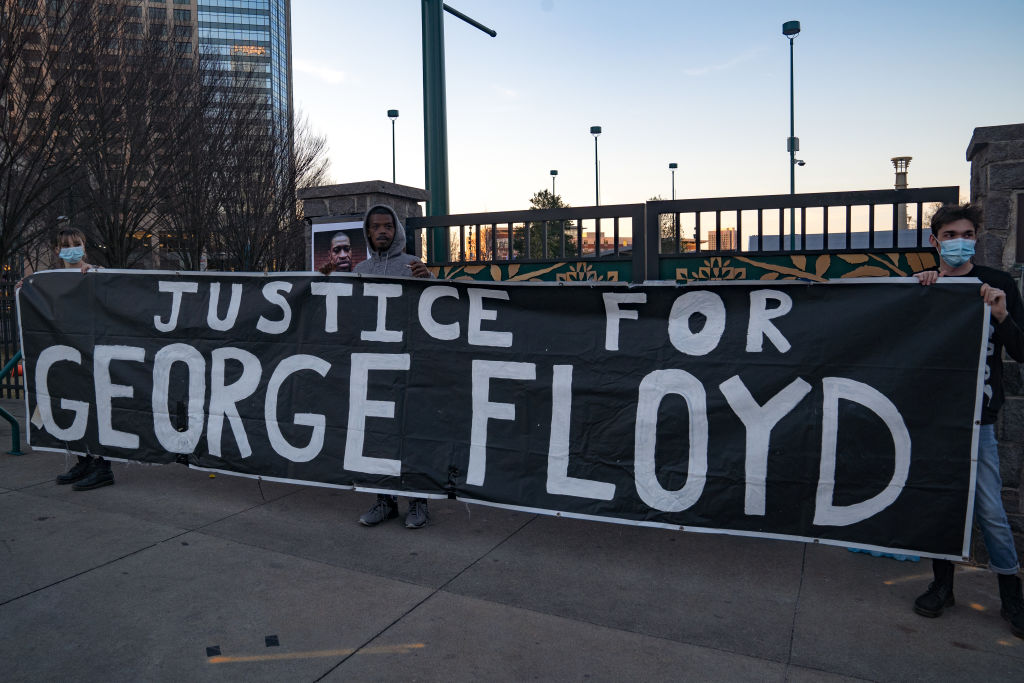The trial of former Minneapolis police officer Derek Chauvin, who killed George Floyd when he pressed his knee into his neck last summer, began Monday with the proceedings being broadcast live in an unprecedented first for the state of Minnesota.
Chauvin has entered a plea of not guilty to second-degree unintentional murder, third-degree murder and second-degree manslaughter charges, The New York Times reports.
In presenting the harrowing footage of the final moments of Floyd's life, prosecutors say Chauvin unintentionally killed Floyd while exerting an excess of force during an arrest on May 25, 2020. According to the news station WRCB TV, Chauvin’s team aims to argue that Floyd’s death was attributed to drug use and other unrelated medical issues. Defense attorneys have also contended that Chauvin was abiding by proper police procedures during the May encounter.
The historic trial will center around specific details regarding the case, which includes Floyd's autopsy, the former police officer’s mindset and finding clarity in legal terms such as "depraved mind" and "culpable negligence."
The trial will take place at the Hennepin County courthouse, a highly secure location in Minneapolis. Due to pandemic precautions, plexiglass walls have been set up inside the courtroom, and witnesses and lawyers have been instructed to wear face masks.
Here are some of the takeaways from day one of the trial.
1. Floyd was on the ground so long, a dispatcher thought the footage was frozen.
According to NBC News, dispatcher Jena Lee Scurry testified that she thought "something was wrong" as she watched a stationary police camera showing Floyd being detained by Chauvin and other officers.
"It had not changed. They were still on the ground …. it was long enough, long enough that I could look back multiple times," Scurry said, responding to questions from Assistant Attorney General Matthew Frank. "I first asked if the screens had frozen because it hadn't changed."
The 45-year-old man had been on the ground under physical restraint for so long that Scurry called Chauvin's supervising sergeant to voice her concerns. In the call, which was played for jurors, the dispatcher shared that she felt the action was beyond her normal duties and referred to herself as a "snitch," for raising the alarm.
2. An EMT said that Chauvin refused to let her check Floyd’s vitals, threatening her with mace.
In Monday's opening argument, prosecutors say that when a bystander, who was also an EMT, approached to attempt to provide aid, the former officer pointed his mace at her and prevented her from administering assistance, MSNBC legal analyst Joyce Alene reported.
Prosecution: “Chauvin does not let up & he does not get up.” Watching 9:29 of excruciating video, Chauvin keeps grinding his knee on George Floyd’s neck, ignoring all efforts to get him to care for Floyd & ultimately even an EMT bystander demanding he check for a pulse.
— Joyce Alene (@JoyceWhiteVance) March 29, 2021
She wrote on Twitter that prosecutors argued that Chauvin kept his knee pinned on Floyd’s neck, and ignored all efforts to get care for the physically distressed man.
"Chauvin does not let up & he does not get up," prosecutors said, she wrote.
3. There were two different times reported for how long Chauvin had his knee on Floyd's neck.
MSNBC host Ali Velshi shared that there are two references to the time Chauvin spent on top of Floyd. In the initial Hennepin County Attorney's complaint, the act is associated with the time eight minutes and 46 seconds. However, the body camera video released last summer indicates that the former police officer pinned Floyd's neck under his knee for nine minutes and 29 seconds.
You’ll hear both 8:46 & 9:29 referenced in the trial of Derek Chauvin. 8:46 comes from the Hennepin County Attorney's initial complaint against Chauvin. Police body camera footage released in August showed Chauvin had his knee on #GeorgeFloyd's neck for 9:29.
— Ali Velshi (@AliVelshi) March 29, 2021
As CNN reports, prosecuting attorney Jerry Blackwell underscored the new timing of nine minutes and 29 seconds multiple times, saying to jurors that this time was actually the "three most important numbers in this case."
Blackwell broke down the timing of Chauvin's act into three parts: the first four minutes and 45 seconds as Floyd cried out for help, then, another 53 seconds went by as he writhed due to seizures and the last three minutes and 51 seconds he laid on the ground unresponsive.
According to CNN, Chauvin's defense accepted the legitimacy of the new timing to go along with its own arguments.
4. Multiple people recalled calling “the police on the police.”
Yamiche Alcindor, a White House correspondent with PBS, wrote on Twitter during the trial that prosecutors have detailed that multiple people, including a 911 operator and a number of witnesses, "called the police on the police" after seeing the former officer kneel on his neck for such an elongated amount of time.
The prosecutor in the Derek Chauvin trial detailing that multiple people — including witnesses and a 911 operator — "called the police on the police" after seeing Chauvin kneel on George Floyd's neck for nine minutes and 29 seconds.
— Yamiche Alcindor (@Yamiche) March 29, 2021
Alisha Oyler, a 23-year-old gas station employee who recorded the scene of Floyd's death, told jurors that she was fed up with police “messing with people.” She testified that she didn't see Chauvin change his position even after an ambulance arrived, according to The Daily Beast.
The trial's opening statements along with witness testimonies are expected to proceed for nearly four weeks, then the deliberations will begin as they conclude.
There are three separate charges against Chauvin, which means he could be convicted of all, some or none of them. If convicted of all three, he could face up to 75 years in prison.
